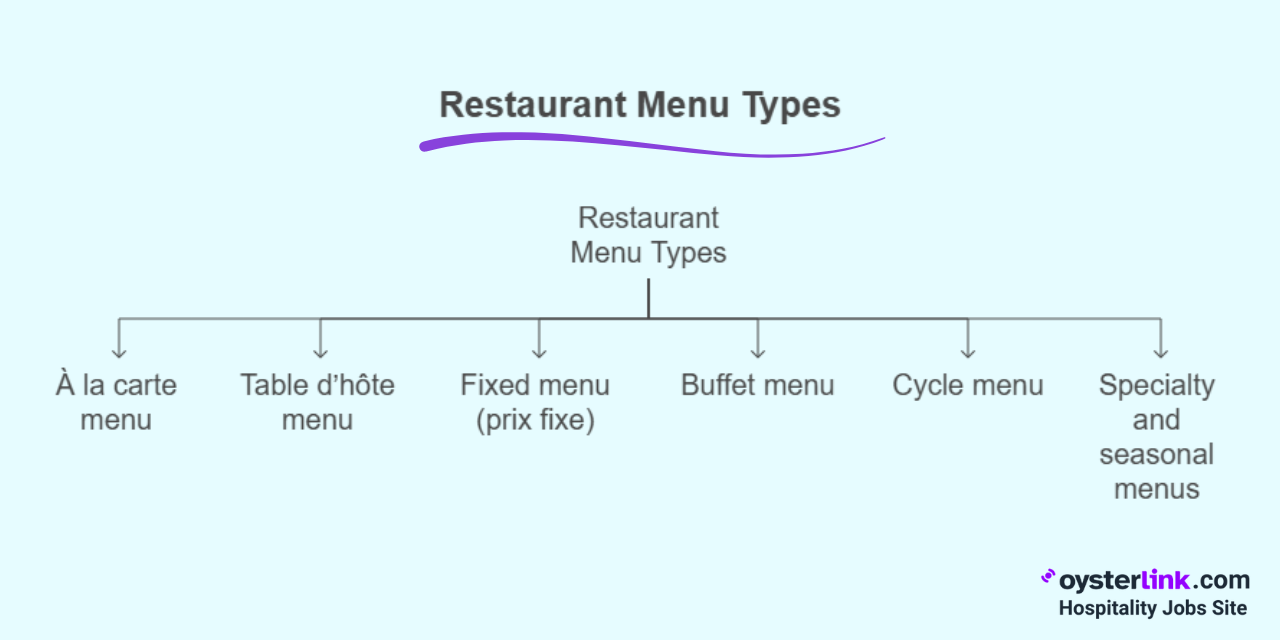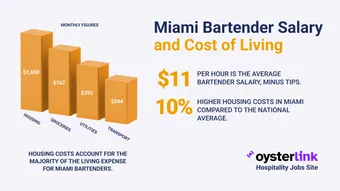A restaurant menu is more than a simple list of dishes — it’s a strategic tool that informs, entices and guides decisions.
Understanding restaurant menus and their types enables both staff and guests to get the most out of every dining experience.
This article explores the different menu options, their purposes and how thoughtful design can elevate your restaurant’s service and profitability.
6 Main Types of Restaurant Menus
Restaurants use different menu types to match customer expectations and operational needs.
Each kind of menu comes with its own structure and fits certain settings or service styles better than others.

Let’s explore the six most common menu types and their characteristics to help you choose the best fit for your restaurant.
1. À la carte menu
An à la carte menu offers dishes individually, with each item priced separately.
Guests have the flexibility to mix and match their starters, mains, sides and desserts exactly how they want, giving them a sense of personalization and control over their meal.
For the restaurant, though, this style can be a bit unpredictable and difficult to manage.
It often requires careful planning and inventory control, as some dishes may sell more than others, potentially leading to higher food costs or waste if certain items aren’t popular.
Manager’s Tip: Remember that à la carte menus let you try out new dishes with minimal risk because you can add or remove items easily based on customer response. However, they do require tight inventory management and a reliable POS system to stay on top of costs and reduce waste.
2. Table d’hôte menu
A table d’hôte menu features a set multi-course meal at a fixed price. Guests typically choose one option per course, but the choices tend to be more limited compared to à la carte.
This format works well for formal banquets, hotel restaurants and special events. Chefs and kitchen teams appreciate how simple it makes prep, helping to keep service smooth and efficient.
Tip for Managers: Table d’hôte menus can really shine at weddings or other big events. You get better portion control and quicker service — just make sure the front-of-house and kitchen staff are on the same page and well-prepped.
3. Fixed menu (prix fixe)
Prix fixe menus present a set list of courses for one price. These might not be very customizable, except for allergies or dietary needs.
You’ll often see prix fixe in fine dining or on holidays. They make it easier to manage the flow of both the kitchen and the dining room — ideal for events or romantic nights out.
Tip for Managers: Prix fixe menus are perfect for tasting experiences or showcasing seasonal dishes. They help control costs and kitchen timing. Make sure your staff can describe each course well and suggest beverage pairings.
4. Buffet menu
With a buffet, guests help themselves with a variety of dishes. Payment might be by the plate, per person or based on weight, depending on how it’s set up.
Buffets are popular at hotels, resorts and events because guests enjoy the wide selection and the freedom to serve themselves what they want.
Still, they require careful planning from the kitchen to keep everything fresh and safe and to reduce food waste.
Tip for Managers: Make sure you have strong food safety routines — keep hot foods hot and label allergens, even at breakfast. It’s also helpful to have a dedicated staff member oversee presentation and refills to keep the setup running smoothly.
5. Cycle menu
Cycle menus repeat a set of meals over a predetermined period — say, every week or month. This regular schedule helps keep things consistent and costs in check.
Institutions like schools, staff cafeterias and hospitals use cycle menus. They make ordering easier and less wasteful.
Tip for Managers: Try a two-week cycle menu for lunch if you have a lot of repeat customers — like in an office park or near a hospital. It keeps things interesting but also helps streamline orders.
6. Specialty and seasonal menus
Specialty and seasonal menus are all about celebrating special occasions, highlighting unique ingredients or showcasing the Chef’s creative flair — think summer grill menus, seafood festivals or autumn harvest features.
They bring a sense of excitement, allowing you to shine a light on seasonal or top-quality ingredients, while also keeping regulars eager for something new.
Chefs love the creative freedom, and guests really enjoy the variety and novelty these menus offer.
For hiring tips and keeping your kitchen inspired, read our article on how to hire a top Chef.
Tip for Managers: Promote your market-fresh finds or themed menus with colorful inserts or in-app highlights. Social media shout-outs help increase reach, too.
Key Concepts in Menu Design and Structure
Beyond choosing a menu type, great design plays a big role in your success.
Details like visuals, pricing and the right language can influence the guest experience and improve your profits.
Involve your kitchen and service staff — group effort pays off.
Menu layout and readability
Menu layout and readability are key to creating a great dining experience.
A well-designed menu should be easy to scan, so guests can quickly find what they’re interested in without feeling overwhelmed.
Arranging sections logically — like starters, mains and desserts — helps guide the eye naturally.
The fonts should be clear and legible, even from a distance, with enough spacing between items so the menu doesn’t feel cramped.
When a menu is easy to read and navigate, it encourages guests to explore more options and can even influence their ordering choices, making everything run more smoothly for the whole team.
Checklist for Managers:
- Group items into “Appetizers,” “Mains” and “Desserts.”
- Highlight popular and signature dishes using color or icons.
- Use at least 12pt fonts for readability.
- Limit dish descriptions to 2–3 concise lines.
- Test menus on paper and mobile devices, as guests often browse on their phones.
- Attractive photos, Chef’s notes and organized categories improve both look and usability, creating a smoother experience for diners.
Menu engineering and pricing strategies
Pricing isn’t just about markup. Menu engineering strategically highlights your most profitable and popular items while downplaying low-margin dishes.
Decoy pricing makes certain options seem like a better deal; a mix of price points appeals to different guests.
Tip for Managers: Regularly review sales and move “star” items to prominent spots on the menu. Retire or revise items that don’t perform well. Use decoy pricing — placing a slightly higher-priced item next to a target item — to influence choices subconsciously.
Descriptive language and menu psychology
Use tempting descriptions — words like “house-cured,” “crispy” or “herb-roasted” to make dishes irresistibly appealing. Vivid, concise wording is key.
For example, “Seared Atlantic Salmon on Lemon Risotto” sounds more appealing than just “fish with rice.”
Encourage Servers to taste specials so they can confidently describe and upsell dishes.
Tip for Managers: Place signature dishes where they catch the eye — top right or center of the menu. Use creative and fun names; “Uncle Pete’s Meatballs” may attract more orders than just “meatballs.”
Dietary needs and customization
Dietary needs and customization have become more important than ever in today’s dining scene.
Clear communication about options like gluten-free, vegan and allergy-safe dishes helps guests feel welcome and confident in their choices.
When dietary accommodations are clearly marked, it shows you prioritize their safety and experience, which can really boost your reputation and encourage repeat visits.
Tip for Managers: Use symbols or labels (GF, V, allergen icons). Train staff to handle allergy questions effectively — quick and accurate responses are vital. Consider allowing guests to customize dishes (swap sides, adjust spice levels) to foster loyalty.
Feedback loops and staff training
Regularly ask Servers for guest feedback on the menu — use quick surveys or team chats. Hands-on tasting and training help staff confidently promote dishes.
After updates or new labeling, discuss feedback during shift meetings and make adjustments as needed.
Choosing the Right Menu Type: Factors To Consider
Choosing a menu style isn't a one-size-fits-all decision. Think about:
- Restaurant theme and concept (casual, upscale, ethnic cuisine or event-focused)
- Target customer demographics (age, preferences, spending habits)
- Kitchen and staffing capabilities (ability to customize, Chef’s specialization)
- Price positioning and profit margin goals
- Customer experience expectations (speed, variety, ambiance)
- Inventory flexibility: How often do you need to vary items or manage overstock? Cycle or seasonal menus can help reduce waste.
- Tech support: Is your team comfortable with digital menus and QR codes? Printed menus still matter for guests who prefer traditional options.
Think through these considerations carefully, involve your Chef and key staff in planning and avoid surprises during rollout.
The Evolution of Restaurant Menus
Menus have come a long way. Once, they were just printed on paper, static and requiring reprints whenever something changed.
Today, technology allows for quick, easy updates through online platforms and QR codes, making menus much more flexible.
Digital displays and contactless ordering not only boost convenience for guests but also improve efficiency for staff.
QR codes linked to digital menus enable diners to browse and order without touching anything — an especially valuable feature during health-conscious times.
Online menus can be updated instantly to highlight seasonal dishes, ingredients or special promotions, supporting continuous innovation.
Modern menus also focus on sustainability — highlighting eco-friendly ingredients and responsibly sourced products.
Visually striking, shareable dishes that stand out on social media are playing an increasingly influential role in shaping menu choices.
Getting started is simple: Link a basic PDF menu via QR code, and then as everyone becomes more comfortable with digital solutions, explore more interactive options.
Highlighting local ingredients and Chef’s specials aligns with sustainability trends, and offering printed menus upon request ensures every guest feels welcome.
This balanced approach helps restaurants stay current — meeting the evolving expectations of today’s diners while embracing new technology.










Loading comments...